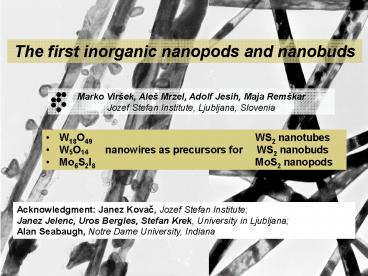Acknowledgment: Janez Kovac, Jozef Stefan Institute
1 / 26
Title: Acknowledgment: Janez Kovac, Jozef Stefan Institute
1
The first inorganic nanopods and nanobuds
Marko Virek, Ale Mrzel, Adolf Jesih, Maja
Remkar Jozef Stefan Institute, Ljubljana,
Slovenia
- W18O49
WS2 nanotubes - W5O14 nanowires as precursors for WS2
nanobuds - Mo6S2I8
MoS2 nanopods
Acknowledgment Janez Kovac, Jozef Stefan
Institute Janez Jelenc, Uros Bergles, Stefan
Krek, University in Ljubljana Alan Seabaugh,
Notre Dame University, Indiana
2
References Carbon carbon nanotubes
S. Ijima, Nature, 354, 56 (1991) carbon onions
D. Ugarte, Nature 1992, 359,
707 carbon nano-peapods B. W. Smith et
al., Nature, 1998, 396, 323. carbon nanobuds
A. G. Nasibulin et al., Nature nano. 2,
156, 2007 Inorganic materials nanotubes and
inorganic fullerene-like nanoparticles (MoS2,
WS2) R. Tenne et al., Nature 1992, 360, 444. L.
Margulis et al., Nature 1993, 365, 113.
The WS2 nanobuds as a new hybrid nanomaterial,
submitted to Nano Letters Inorganic nanotubes as
nanoreactors the first MoS2 nanopods, Adv.Mater.
in press
3
Two possible stacking of adjacent MoS2 and WS2
molecular layers hexagonal 2Hb and rhombohedral
3R
Elevated pressures
Normal conditions
Plate like crystals stability
4
WS2 nanobuds and nanotubes
Cherry fruit buds
5
Single ReO3 chain
Tungsten oxides
Magneli phases
WO3
W5O14
W18O49
WO3-x xlt0.13
WO3 octahedrons connected trough the corners
across oxygen atoms. Non-conducting.
Some octahedrons connected trough the edges -
crystallographic share planes.
Formation of pentagonal columns and hexagonal
channels. Controlled gapped semiconductors or
metallic behavior.
W5O14 I.J. McColm, et al., J.Solid State Chem.
1978, 23, 33
6
Synthesis of W5O14 and W18O49
WS2,
I2
, NiI2
WO3, W, I2
W5O14
W18O49
I2
I2
T1 ? T2
T1 ? T2
Temperature 1000 K Temp. gradient 5.7
K/cm Pressure 10-3 Pa
Duration 2 weeks Cooling rate 15 ?/
hour Transport agent Iodine
Chemical transport reaction R. Nitsche,
J.Phys.Chem.Solids 17 (1960) 163
7
SEM, TEM of W5O14 and W18O49
Blue crystals, average thickness 100 nm, length
up to mm, excellent mechanical stability.
Purple (few hundred nm thick) and blue crystals
(bellow 200 nm thickness), length up to few mm,
brittle
M. Remskar et al., Adv.Func.Mater. 17 (2007) 1974
8
HRTEM, TED and XRD
W18O49
W5O14
a 2.333 nm, c 0.3797 nm
tetragonal
a 1.833 nm, b 0.3706 nm, ß 115,2, c
1.4044 nm monoclinic
9
AFM, STM, STS on W5O14
AFM non-contact mode
STM topography showing corrugation
Scanning tunneling spectroscopy (STS) showing
metallic conductivity
10
XPS on W5O14
The Ni 2p core level spectrum associated with
Ni(OH)2 compound.
The W5O14 nanowires show non-zero density of
states at Fermi level metallic conductivity.
The W 4f core level spectrum reveals 6 and 5
oxidation numbers.
Oxygen bonds with tungsten in the oxidation state
lower than 6.
Janez Kovac
11
Transport measurement on W5O14
Schematic cross section of three-terminal nanowire
Potential vs. tube current for a 600 ?m long
double-stranded nanowire (120 nm and 155 nm in
radius) with two 150 mm diameter Al contacts
connecting the tube at either end and another
contact touching the tube along its length.
Alan Seabaugh
12
Sulphurization of the W18O49
Mixture of H2S/H2/Ar ( 1198) Gas flow cca.
30ml/min Duration 2 hours Temperature 830 C -
845 C
W18O49 converted to WS2 completely
TEM WS2 nanotubes decorated by thin plate-like
crystals
13
Sulphurization of the W5O14 at two slightly
different temperatures
839 ºC
845 ºC
14
Sulphurized W5O14 at lower temperature WS2
nanotubes
The tubes are smaller in diameter than the W5O14
precursors.
Dome-closed tube.
Longitudinal split of precursor crystal to
several WS2 nanotubes.
15
Double-layer by double-layer growth mode
The diffusion along the inner surface is
rendered. The wall grows in double layer mode-
i.e. in accordance with typical growth mode in
Au-alloyed nanotubes.
16
The first stage of sulphurization
Double layered WS2 envelope around W5O14 crystal.
The substrate is thin layer of WS2
17
Sulphurized W5O14 at higher temperature WS2
nanobuds
Hexagonal 2Hb stacking. - The lattice of the tube
wall is relaxed.
Growth of the WS2 fullerenes by diffusion process.
18
Faceted shape of the WS2 fullerenes
Hexagonal 2Hb polytype
19
WS2 nanobuds
20
The first MoS2 nanopods (Advanced Materials
in press)
21
Synthesis of MoS2 nanopods
- Mo6S2I8 nanowires from elements.
- MoS2 nanopods from Mo6S2I8 by sulphurization.
The electron diffraction pattern indexed in
accordance with the reported Mo6S2I8 structure
C. Perrin, M. Sergent, J. Chem. Res. (S), 1983,
38.
a 16.405 Å c 11.952 Å hexagonal, space group
P63/m
Growth conditions T 1320 K Duration 72 hours
22
MoS2 pea-pods mama- tubes
3R polytype
23
Well ordered nanotube walls
An early nucleation stage of the fullerene
formation in agreement with 3R polytype
24
STM and AFM- non contact mode
Release of MoS2 fullerenes under ultra-sound
agitation
25
Conclusions
- The W5O14 phase was for the first time
synthesized as a homogeneous tungsten oxide
compound at temperatures bellow 1000 C. The
presence of nickel is crucial for the
stabilization of the phase. - Sulphurization of the W5O14 leads to a growth of
relaxed WS2 nanotubes and WS2 fullerenes WS2
nanobuds. The sulphurization takes place in
double-layer growth mode. - The Mo6S2I8 compounds can grow in nanowire
morphology with length up to several millimeters.
Their sulphurization leads to the formation of
the first MoS2 pea-pods. - So-called mama- tubes serve as nanoreactors and
afterwards as safe nanocontainers of MoS2
fullerene-like particles. Very thin nanotube
walls break under ultrasound stimulation.
This work was financed by Ministry of Higher
Education, Science and Technology of the Republic
of Slovenia and by FOREMOST project of the
European Union 6-th Framework Program under
contract NMP3-CT-2005-515840.
26
Resonance Raman spectrum, 632.8 nm (1.96 eV)
He-Ne laser excitation line
The peak at 496 cm-1 is typical for the MoS2
fullerenes and is believed to be disorder-induced
in origin, corresponding to phonons in the
vicinity of the Brillouin zone edge and arising
from the high density of phonon states.































